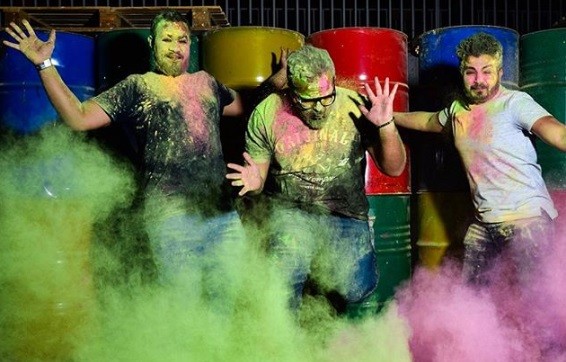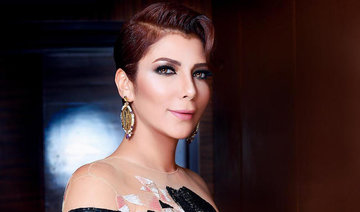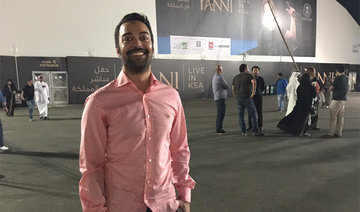JEDDAH: Bringing together a combination of light and color with stimulating artworks and live performances, Raibal Events and Silent Echo staged a “Luminarium” event in Jeddah over the past 10 days. Supported by the General Entertainment Authority (GEA), the event was held between Jan. 10-20 and attracted thousands of visitors.
The luminarium tour involved a spectacular walk through a monumental inflatable sculpture of color and light. Visitors removed their shoes before entering an airlock and explored the installation. The light and shimmering colors inside the inflatable sculpture created a sense of wonderment for explorers of all ages.
The luminarium was designed by Alan Parkinson in the early 1980s in Nottingham, UK, but the idea came into existence in 1992. Inspired by natural forms and geometric solids, the luminarium is a maze of winding paths and dome structures where the visitors lose themselves in sensory bliss.
Visitors were seen sitting and lying back while enjoying the ambience in the cocooning, pod-like structure. Bandr Al-Meeman, founder of Silent Echo, said: “The scale of the structure is impressive even before anyone steps through the airlock and, once inside, it will mesmerize them. A truly unmissable experience of light and color as it plays with the senses.”
Explaining more about the experience, he said that it was created to support the special needs community, especially those who have autism. He added that since 1992, it has been set up in five continents and more than 40 countries where more than three million guests visited the attraction.
Moreover, describing the structure, he added, “The luminarium’s pneumatic environment provides a utopian vessel to contain light’s radiant brilliance and through cavernous domes visitors move in a medium of saturated color, in a world apart from the normal and everyday routine.
“It took us two months to construct the 1000sqm luminarium dome-like structure that consists of three colors and one tree,” he said.
Nasser Al-Nasseri, executive projects director of Raibal Events, said: “It was a nice opportunity to work with Silent Echo, a Switzerland-based company, and spread the idea of luminarium that is light and color in the Saudi and Middle-Eastern culture. However, having the luminarium tour alone was not enough, so we decided to expand the event by adding four other activities to the main activity.”
“We brought more entertaining activities related to the event theme — that is light and color — while focusing on all ages, both kids and adults, who have a passion for arts and entertainment,” he added.
Four different zones consisting of a kids’ color experience, show and performances, art stations and a color adventure zone were added to the event.
“This unique event bears testament to Saudi Arabia’s engaging and creative evolution, presenting to audiences a diversity of entertaining activities and experiences that underpin the Kingdom’s position as an entertainment hub,” Al-Nasseri said.
Speaking to Arab News, he explained that the entire production was built in-house using recycled materials. LED lights were made with the help of empty boxes that were initially containers used in factories to store liquids and chemicals.
The creative juices really seemed to be flowing in every corner of the event. The art station that had different workshops, 3D-modeling and art works was enthralling. The color maze presented an innovative way for visitors to have fun while they threw color powder at each other while finding their way out of the maze.
The art station zone was organized by Ninetyd, a local creative platform. At the event, they brought together more than 14 creative individuals — artists, designers, 3D artists, digital artists and animators — to present their work.
Mona Balhemar, CEO of Ninetyd, said, “Ninetyd basically runs a creative project called Passionures. The main theme of this project is to make creativity a living and bring opportunity for creatives and artists. The main aim for us to take part in luminarium was as it’s all about colors and arts, we decided to do interactive booths with the help of artists registered in our platform and help them display their work.”
Hazzan Felemban and Wijdan Al-Ghalbi, both pottery makers, displayed their products. As did Amal Abdullah who specializes in digital-art coffee mugs and cups and is founder of the Miss Coffee brand. “It was a unique experience to do live art on mugs and cups. People had a chance to understand and appreciate this kind of art,” Abdullah told Arab News.
Hind Bataweel, founder of Colorfly, said “Our space at luminarium was more like a healing space. People came to vent and express themselves freely with paints. Expression varies from one person to another, so it’s more likely a free self-expression. Our participation in luminarium was more about adult adventure so they could express themselves with color using their hands and feet. However, kids came along too to express themselves, paint without brushes, splash colors on the walls, which expressed freedom.
“The concept of painting and getting creative while expressing their feelings turned out to be one of the main attractions during the event as people sometimes want to feel creative because it is such healing process,” Bataweel added.
Visitors came in groups of friends, with colleagues, as couples and some people even came by themselves to make new friends. Live performances by musical bands and a live radio station organized by Mixed FM made it an exciting few days to remember.
Luminarium event captivates Jeddah audiences with light and color
Luminarium event captivates Jeddah audiences with light and color

How science is reshaping early years education

DUBAI: As early years education comes under renewed scrutiny worldwide, one UAE-based provider is making the case that nurseries must align more closely with science.
Blossom Nursery & Preschool, which operates 32 locations across the UAE, is championing a science-backed model designed to close what it sees as a long-standing gap between research and classroom practice.
“For decades, early years education has been undervalued globally — even though science shows the first five years are the most critical for brain development,” said Lama Bechara-Jakins, CEO for the Middle East at Babilou Family and a founding figure behind Blossom’s regional growth, in an interview with Arab News.

She explained that the Sustainable Education Approach was created to address “a fundamental gap between what we know from science and what actually happens in nurseries.”
Developed by Babilou Family, the approach draws on independent analysis of research in neuroscience, epigenetics, and cognitive and social sciences, alongside established educational philosophies and feedback from educators and families across 10 countries. The result is a framework built around six pillars; emotional and physical security, natural curiosity, nature-based learning, inclusion, child rhythms, and partnering with parents.
Two research insights, Bechara-Jakins says, were particularly transformative. “Neuroscience shows that young children cannot learn until they feel safe,” she said, adding that stress and inconsistent caregiving can “literally alter the architecture of the developing brain.”
Equally significant was evidence around child rhythms, which confirmed that “pushing children academically too early is not just unhelpful — it can be counterproductive.”
Feedback from families and educators reinforced these findings. Across regions, common concerns emerged around pressure on young children, limited outdoor time and weak emotional connections in classrooms. What surprised her most was that “parents all sensed that something was missing, even if they couldn’t articulate the science behind it.”
At classroom level, the strongest body of evidence centres on secure relationships. Research shows that “secure attachments drive healthy brain development” and that children learn through trusted adults. At Blossom, this translates into practices such as assigning each child “one primary educator,” prioritising calm environments, and viewing behaviour through “a neuroscience lens — as stress signals, not misbehaviour.”
Bechara-Jakins believes curiosity and nature remain overlooked in many early years settings, despite strong evidence that both accelerate learning and reduce stress. In urban centres such as Dubai, she argues, nature-based learning is “not a luxury. It is a developmental need.”
For Blossom, this means daily outdoor time, natural materials, gardening, and sensory play — intentional choices aimed at giving children what science says they need to thrive.















